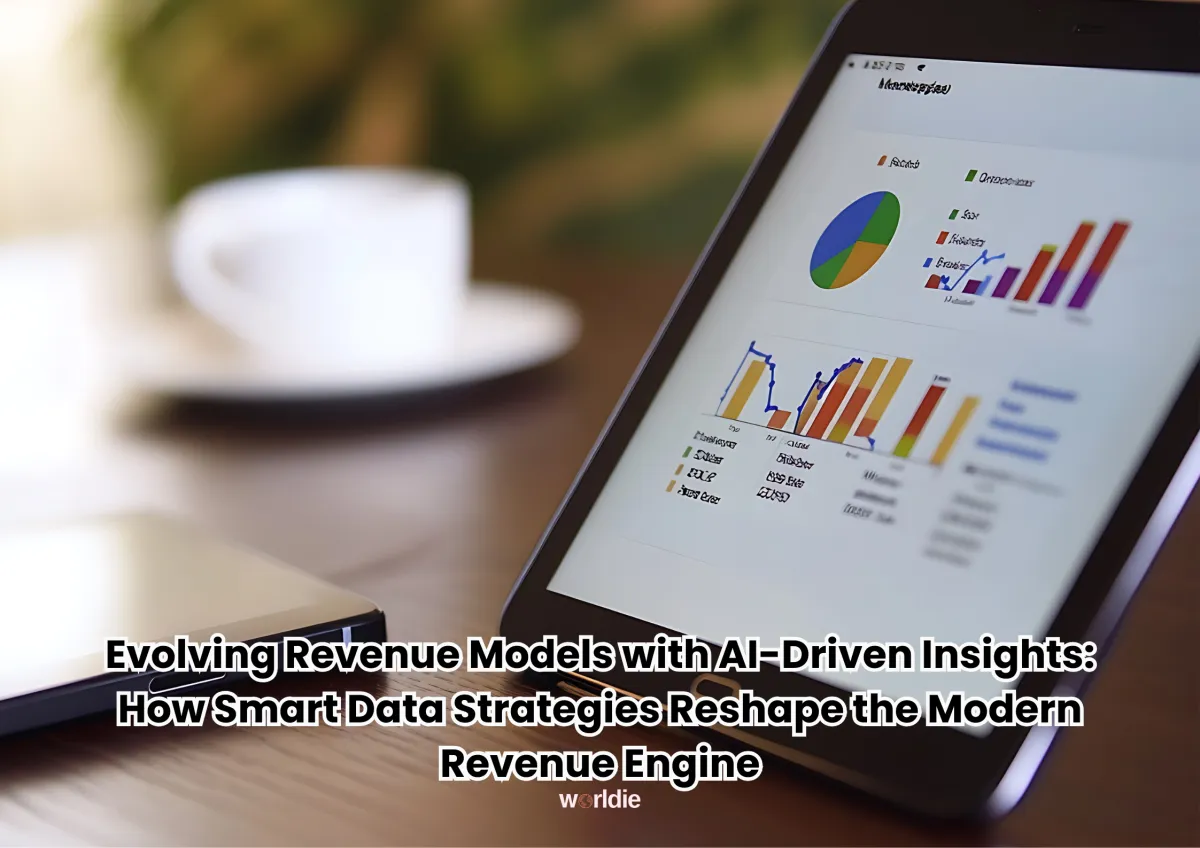
Evolving Revenue Models with AI-Driven Insights: How Smart Data Strategies Reshape the Modern Revenue Engine
Evolving revenue models with AI-driven insights represents a shift from intuition-based decision-making to intelligent, data-driven adaptation. It’s about embedding artificial intelligence into the very core of how a business earns, optimizes, and sustains revenue over time. Rather than relying on historical assumptions or reactive strategies, AI-driven insights allow leaders to predict, personalize, and continuously refine revenue streams based on real-time market behavior.
In simple terms, it means transforming the business from being reactive to being anticipatory. Companies that leverage AI to shape their revenue models can detect shifts in demand before they occur, respond to them faster, and adjust their strategies dynamically. For organizations aiming to future-proof their growth, AI is not just an enhancement—it’s the new foundation for revenue resilience.
Worldie AI empowers this transformation by designing, building, and deploying intelligent systems that help businesses generate consistent growth through precision and adaptability.
Why Traditional Revenue Models Limit Growth
Traditional business models often fail to keep up with modern complexity. Static pricing strategies, rigid forecasting, and manual processes create barriers that slow progress and reduce profitability. Decision-making becomes guesswork when data is underutilized or scattered across disconnected systems. This lack of integration prevents leaders from seeing the full picture of customer behavior, market trends, and operational performance.
For many businesses, this leads to several challenges—unpredictable revenue cycles, inefficient pricing, poor retention rates, and wasted marketing spend. The limitation isn’t in ambition but in visibility. Without access to unified, real-time insights, even the most experienced executives can find themselves reacting too late to market changes.
AI-driven insights solve this problem by merging predictive analytics with real-time data. They provide clarity where there was once uncertainty, allowing businesses to act before disruption happens.
The Evolution from Static to Adaptive Revenue Systems
A truly adaptive business model doesn’t rely on fixed assumptions. Instead, it continuously learns from new information and recalibrates itself for optimal performance. AI brings this capability to life by recognizing emerging patterns, learning from historical outcomes, and recommending the best course of action based on constantly changing data.
Imagine a retailer that adjusts pricing automatically based on customer demand, seasonality, and inventory levels. Or a SaaS company that predicts customer churn weeks before it happens and launches targeted retention campaigns automatically. These are not futuristic ideas—they’re active examples of how AI-driven revenue systems function in practice.
Adaptive models are built on the understanding that the market never stands still. Every decision should evolve as conditions evolve. AI gives businesses the agility to do just that.
How AI-Driven Insights Reshape Revenue Strategy
AI has the power to reshape every element of a revenue model. It turns scattered data points into intelligence that drives action. Instead of executives reviewing quarterly reports to identify what went wrong, AI provides instant visibility into what’s happening right now—and what will happen next.
Businesses can use AI to identify new revenue opportunities hidden in customer behavior data. They can predict demand with higher accuracy and even anticipate shifts in consumer preferences. Marketing becomes less about broad messaging and more about intelligent targeting. Pricing can shift dynamically based on value perception and market sensitivity.
This kind of intelligence allows companies to transform their approach from “what happened?” to “what will happen next, and how can we maximize it?”
Industry Applications of AI-Driven Revenue Models
AI’s ability to evolve revenue models applies across every sector. In retail, AI enables real-time pricing optimization, product recommendations, and inventory forecasting, ensuring that stock aligns perfectly with demand. In healthcare, predictive systems improve patient engagement and optimize service pricing for efficiency and outcomes.
In finance, machine learning algorithms can detect emerging market opportunities and mitigate risks, improving both profit margins and compliance accuracy. Manufacturing benefits from predictive maintenance models that reduce downtime and operational waste, leading to a more stable and cost-efficient revenue flow.
Across industries, AI doesn’t just streamline processes—it redefines how value is generated, sustained, and expanded.
The Worldie AI Framework: Design, Build, and Release
Worldie AI follows a strategic and systematic approach to AI implementation. The process starts with design, where the business goals are analyzed and mapped to areas where AI can make measurable impact. It’s about identifying which parts of the revenue model need to evolve—pricing, customer retention, forecasting, or sales optimization.
Next is build, where custom AI architectures are developed to suit the business’s unique infrastructure and data maturity. Each system is designed to integrate seamlessly with existing workflows, ensuring zero operational friction.
Finally, the release phase focuses on deployment, monitoring, and continuous optimization. The models are tested against real-world scenarios, refined through feedback loops, and scaled to achieve sustainable impact. Worldie AI’s strength lies in building solutions that continue to learn and improve over time.
Challenges in Implementing AI for Revenue Transformation
AI adoption can face significant obstacles, especially when businesses lack the data infrastructure or technical alignment needed for success. The most common challenges include fragmented data systems, poor data quality, resistance to organizational change, and a shortage of internal expertise.
To overcome these barriers, companies need a strategic implementation plan. Worldie AI helps organizations create clear frameworks that connect technical development with business objectives. It ensures data pipelines are clean, models are interpretable, and every decision aligns with measurable goals.
Rather than rushing into automation, Worldie AI prioritizes readiness, governance, and scalability—building AI systems that not only perform well today but continue to evolve tomorrow.
Key Metrics for Evaluating AI Success
Success in AI-driven revenue models extends beyond financial growth. It includes measurable improvements in predictive accuracy, operational efficiency, and customer engagement. Businesses track metrics such as forecast precision, customer retention, average revenue per user, and the time saved in manual reporting.
AI allows leaders to see revenue not as a static goal but as a living system that evolves continuously. When these insights are monitored consistently, they reveal patterns that drive smarter decision-making and sustained profitability.
Transformations Achieved Through AI
Businesses that have embraced AI-driven insights are already witnessing significant outcomes. An international retailer that adopted AI-powered pricing saw its profit margins increase without raising prices. A SaaS company using predictive analytics cut customer churn by nearly half while improving sales efficiency.
These transformations demonstrate a universal truth—AI does not just support growth; it sustains it. The more an organization feeds its systems with quality data, the smarter and more precise its decisions become.
The Role of Human-AI Synergy
Even the most advanced AI systems rely on human creativity, strategy, and ethical oversight. The most successful organizations are those that treat AI as a partner rather than a replacement.
Worldie AI believes in the synergy between human insight and artificial intelligence. The AI handles complexity at scale, processing millions of data points in seconds, while human leaders interpret, refine, and strategize around those insights. The result is a powerful hybrid model that combines analytical precision with visionary thinking.
Preparing for the Future of Revenue Evolution
The future belongs to adaptive systems—businesses that can change course instantly based on real-time insights. Revenue models will become more fluid, responding instantly to customer preferences, market shifts, and even geopolitical changes.
In this environment, AI will serve as both the engine and the compass of decision-making. Companies that fail to integrate AI into their revenue strategies risk becoming stagnant, while those that embrace it will redefine growth as a continuous, data-fueled process.
Worldie AI’s mission is to help organizations lead that evolution by providing the frameworks, systems, and intelligence they need to move from traditional growth to scalable transformation.
FAQs: Evolving Revenue Models with AI-Driven Insights
1. What does evolving revenue models with AI-driven insights actually involve?
It involves using AI technologies to interpret data, predict trends, and optimize revenue streams in real time. Businesses can identify new opportunities, adjust strategies dynamically, and make smarter, faster decisions that improve long-term profitability.
2. How does AI help in creating more sustainable revenue growth?
AI provides predictive visibility into customer behavior and market conditions. This enables proactive decision-making that minimizes risk and maximizes performance, helping businesses sustain growth without relying on outdated assumptions.
3. Is AI-driven revenue evolution only for large enterprises?
Not at all. Mid-sized and even small businesses can adopt AI tools tailored to their scale. Starting with focused applications like customer segmentation, demand forecasting, or marketing automation can deliver quick and measurable results.
4. What are the biggest challenges in evolving revenue models with AI?
Common challenges include poor data quality, limited integration between departments, and uncertainty about ROI. The right implementation partner, such as Worldie AI, helps businesses address these barriers with structured frameworks and measurable milestones.
5. How does Worldie AI support businesses in evolving their revenue models?
Worldie AI provides end-to-end AI integration—from strategic design to full deployment—focusing on scalability, adaptability, and measurable revenue outcomes. Each system is customized to help the organization operate intelligently and sustainably.

